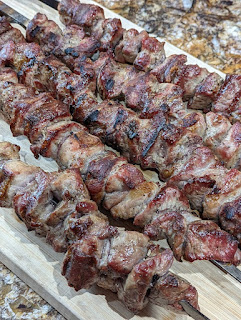I decided to approach this challenge as I did my challenge to cook a main course from Spain, that is, I start with a random address. From that point, I could build the challenge. The problem is that the random address generator provided me with half a dozen addresses, spread across the country. When I found a generator that would give me one address, the website put me in Melfort, Saskatchewan. A city in the middle of a Canadian province that itself is close to the middle of Canada. Now that I had my location, I could move on to the next question: what is the cuisine of Saskatchewan?
For starters, Saskatchewan has the largest proportion of indigenous peoples to the general population of all the Canadian provinces. There are seventy (70) First Nations in the province, with five linguistic groups: Nehiyawak (Cree), Dakota (Sioux), Dene (Chipewyan), Nakota (Assniboine) and Nahkawininiwak (Salteaux). Those nations have arrived in the area approximately 11,000 years ago. They established complex societies on the plains, with cultures recognizing that they were a part of, but not central to all that was around them. The closeness to the land and the environment is a critical part of their beliefs and societies, which also included a recognition of the need to share food and other necessities.
Over the centuries, other groups emigrated and migrated to the Canadian plains. One such group is the Doukhobors, ethnic Russians who, although Christian, rejected the Russian Orthodox church. Doukhobors practiced a different kind of Christianity, one based more on spiritualism. Doukhobors believe that the Bible is not enough, that they have to internalize the living spirit of God. They are pacifists who tended to live in their own communities, rejecting materialism but working together. Needless to say, the Russian government mistreated the Doukhobors, leading to their wish to emigrate to other countries. The government agreed in 1897 to let them leave Russia, but with three conditions: (1) they never return; (2) they pay their own way; and (3) their imprisoned leaders remained incarcerated before they could leave. Many accepted those conditions and they left for Canada, settling in southern Saskatchewan (as well as southern Alberta and British Columbia). Once they arrived, they established "colonies" in block settlement areas or reserves. These included the "Thunder Hill Colony," the "Whitesand Colony," the "Good Spirit Lake Annex," and the "Rosthern Colony."
I have decided that, for this challenge, I would make two recipes from these two ethnic groups. I would first make Bannock, which has its ties to Native American cuisine in the province. I would then turn to the main course, Shishlik, or the kebabs of the Russian immigrants. This latter dish will satisfy the personal culinary challenge.
BREAD
Bannock is a type of bread that originated in Scotland, where is was known as bannach or "morsel." The Scottish prepared used wheat flour to make this bread, which is really like a big biscuit. They cooked the bread by a fire using a griddle known as a Bannock Stone. Bannock could be made in other ways, such as frying it or baking it.
Scottish explorers and traders brought bannock with them as they made their way across the new world, including the United States and Canada. Some indigenous peoples, such as the Metis, adopted the bread and made it their own. Rather than using wheat, as the Scots did, the indigenous people used corn flour or flour made from local plants to prepare the bread.
For this recipe, I wanted to try to recreate the bread using recipes from Saskatchewan. One recipe paired the Bannock with chokecherry syrup. Chokecherries are tart and bitter little berries. The range of these little berries runs from the plains of Canada south to the northern United States. The berries served as an important part of the diet for indigenous nations who lived in that region. While I searched to find chokecherries online, I was unable to do so (most likely because I was making this recipe out of season). If one cannot find chokecherries, the recommended substitute is tart cherries. However, I could not find tart cherries in the store and I did not want to buy them online. In the end, I decided that I would simply use some cranberries that I had in the freezer, which were left over from the holidays.
BANNOCK (LUSKNIKN) WITH CHOKECHERRY SYRUP
Recipe from Jenni Lenard, available at Refinery29
Ingredients (for the bannock):
- 3 cups whole wheat flour
- 3 cups all-purpose flour
- 3 tablespoons baking powder
- 1 teaspoon salt
- 1/8 cup brown sugar
- 1/2 cup oil or melted lard
- 3 to 3 1/2 cups cold water
- 2 cups chokecherries, rinsed well (substitute tart cherries)
- 2 cups water
- 3 cups sugar
- 1 tablespoon lemon juice
- 2 pounds of chicken, pork or lamb, cut into 1 1/2 inch cubes
- Large onions sliced
- Kosher salt
- Freshly ground black pepper
- Canola oil



No comments:
Post a Comment